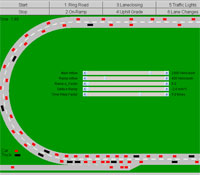Traffic Rerouting for Unplanned Events [TRUE] | |
 |
PIs: Sharad Mehrotra |
|
Our TRUE testbed simulates a geographically dispersed disaster such as an earthquake and studies the role of information technology in coordinating large-scale activities such as evacuations and forestalling cascades. After an unplanned event, emergency responders need the ability to minimize loss and disruption through efficient traffic re-routing. Although transportation models are widely used in public policy, these methods have not been adopted for regional emergency response. Faster computers, widespread use of handhelds and wireless networks now make it possible for responders to detect impediments to traffic flow in real time and calculate routing alternatives in near-real time. We propose an Internet Mapping System (IMS) that models the impact of unplanned events with the help of user input and generates a suite of evolving routes and evacuation alternatives, which will minimize traffic disruption. Such a system would use detailed, building-level activity data to disaggregate Origin-Destination matrices and estimate evacuation demand. Using earthquakes as testbed, damage to the network will be estimated through EPEDAT. This will allow for both simulations and real-time damage estimates using USGS ShakeMaps. For other unplanned events, users will be able to define custom scenarios by specifying locations, regions, or transportation corridors associated with hazards. Alternatively, users will have the option to import avoidance areas from tools such as plume models (ALOHA, CAMEO), or flood models (HAZUS-MH). Given network capacity, the system will establish route alternatives so that the aggregated time to traverse the route (linear detour), or the time exposed to the event (evacuation) is minimized. This regional evaluation will involve route enumeration that will rely on massive parallel computing capability for real-time results. Using the Moore-Pipe algorithm, a One-to-All path from a specific location will be established under the iterative congestion level. Each thread in the parallel system will take the path information, and establish updated path by using the Dual-Simplex algorithm. Another set of parallel processors will be used to estimate equilibrium traffic flow and congestion level on the network by using the Path-based Simplicial Decomposition Network Assignment Algorithm. The route options will be assessed through a Dynamic Control Process. Initial demand and capacity will be estimated using a variable demand function to avoid infinite travel cost associated with isolated network areas. Observed capacity from field sensors and ground personnel will be used to supplement the initial estimation. From the capacity, a suite of routes will be generated and detours will be implemented. Based on the observed results of implementation, the rerouting algorithm is run again and another suite of routes is generated. In this manner, the detours evolve over time, assuring the most efficient routes possible at each phase of the evacuation or recovery process. The resulting routes will be available through wireless networks for response workers to implement in real time. Additionally, as internet connections become available in automobiles, the public will have access to the dynamically generated detours.
| |
